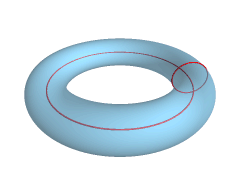|
(2018
midterm assignment) Model Student Midterm answers 2018 #1: Long Essays (Index) |
LITR 4328 |
 |
Annie Tran
Exploring Romanticism through
the Gothic and the Sublime
We are now almost halfway through the course, and I have not fully reconciled my
preconceived notions of Romanticism with the definition and concepts that I
learned in class. Naturally, the modern ideas like the hopeless romantic,
the overly sentimental, and the sappy love story come to mind when I think of
Romanticism. “In everyday modern English, ‘Romantic’ commonly refers to
“feelings of love, desire, or escape and ‘romance’ is used to describe a love
story” (Romanticism). According to this definition, my previous knowledge
of the Romantic period in American literature is not wrong; however, it is
incomplete with many gaps to be filled.
For instance, I discovered that there is a “dark side” to Romanticism that is
usually attributed to Edgar Allan Poe’s works, but the works we read by Washing
Irving have plenty of dark imagery, too. On the other hand, Ralph Waldo
Emerson’s works represent “daylight” Romanticism—typically associated most with
the Transcendentalism movement. Maria Susanna Cummins uses sentimentality
to elevate the dull domestic themes in her works. We spent most of our
class discussions on the Gothic and Sublime that persist across the Romantic
genre. I attempt to chronicle how my understanding of the Romantic genre
developed by revisiting the sublime in Emerson’s Nature, the sublime and
the gothic in Irving’s Rip Van Winkle and Poe’s Ligeia, and the sublime
and sentiment in Cummins’s Lamplighter.
Emerson’s Nature, as the title and the text, embodies a major identifying
form of the Romantic style: “nature as beauty and truth, esp. the sense of
nature as the sublime (god-like awesomeness mixing ecstatic pleasure mixed with
pain, beauty mixed with terror)” (Romanticism). In the presence of nature,
Emerson is filled with wonder and reverence. He experiences the sublime in
“crossing a bare common, in snow puddles, at twilight, under a clouded sky,
without having in my thoughts any occurrence of special good fortune, I have
enjoyed a perfect exhilaration. I am glad to the brink of fear” (12).
Here, the sublime describes “beauty mixed with terror” as he is faced with
nature’s “grand or elevated scale” compared to his being. Similarly, those
of the Christian faith can attest to experiencing the sublime within the
relationship with God.
Another component of the Romantic style is the “belief in children’s innocence
and wisdom.” Emerson believes that nature can fulfill his desire to return
to that innocence, for “in the woods too, a man casts off his years, as the
snake his slough, and at what period soever of life, is always a child. In the
woods, is perpetual youth” (12). Emerson suggests that nature allows man
to shed his adulthood, and “return to reason and faith” (12). Emerson uses
the molting snake imagery to evoke the emotions of lies and betrayal, much like
how adulthood represents corruption and betrayal in the Romantic style.
Emerson encounters the sublime in nature, who acts as a guardian and says, “he
is my creature, and maugre all his impertinent griefs, he shall be glad with me”
(11). Nature, in Washington Irving’s tale, does not treat Rip Van Winkle
the same way. Unlike Emerson’s transcendental experience, Van Winkle’s
experience is much darker. He started for the woods with the intent to
commit suicide. In the woods, Van Winkle comes across “a strange figure
slowly toiling up the rocks, and bending under the weight of something he
carried on his back” (16). The grotesque figure causes fear and
anxiety to settle over Van Winkle, yet he is compelled to help the person.
The reader can sense the foreboding atmosphere.
Irving sets the gothic tone in this passage to reinforce the sublime in the next
passage. Van Winkle follows the stranger deeper into the woods until the
gothic environment where “impending trees shot their branches, so that you only
caught glimpses of the azure sky and the bright evening cloud” collides with the
sublime of “something strange and incomprehensible about the unknown, that
inspired awe and checked familiarity” (17). Nature does not embrace Van
Winkle like in Emerson’s encounter. Instead, nature seizes his desire to
escape from “the here and now of drab reality” (Romanticism), and it tosses him
into the future. Irving intertwines the gothic and the sublime and
connects these elements to the Romantic style.
No one quite raises the elements of the gothic and the sublime to the forefront
of the Romantic genre as Edgar Allan Poe. Ligeia is riddled with
the Romantic rhetoric that includes qualities, such as “intensification of
feeling or emotion, extremes, excess, superlatives, and allusion to archaic
subjects or texts” (RomantRhet). The protagonist takes the reader to the
moment that he first laid eyes on lady Ligeia with all the glories of his
“wildly romantic offering on the shrine of the most passionate devotion” (2) to
her. The protagonist is captured by the sublime that is Ligeia’s “beauty
mixed or edged with danger” as he states, “Yet, although I saw that the features
of Ligeia were not of a classic regularity—although I perceived that her
loveliness was indeed ‘exquisite,’ and felt that there was much of ‘strangeness’
pervading it, yet I have tried in vain to detect the irregularity and to trace
home my own perception of ‘the strange’” (4).
The sublime entices the protagonist, and he is obsessed with the pursuit of
figuring out the strange. He states, “I saw not then what I now clearly
perceive, that the acquisitions of Ligeia were gigantic, were astounding; yet I
was sufficiently aware of her infinite supremacy” (8). Then, as fierce as
his love for Ligeia when she was living, is his grief for her when she died.
Whereas Poe uses the sublime to accentuate Ligeia’s worship-worthy beauty, he
uses the gothic space to reflect the protagonist’s haunted, grieving mind:
The gloomy and dreary grandeur of the building, the almost savage aspect of the
domain, the many melancholy and time-honored memories connected with both, had
much in unison with the feelings of utter abandonment which had driven me into
that remote and unsocial region of the country. (14)
Poe uses correspondence, an element of the Romantic literature, to emphasize the interaction between protagonist’s emotions and his surroundings.
Maria Susanna Cummins appeals to sentimental value and the sublime to express
Gerty’s emotions as she interacts with her kitten in The Lamplighter.
True Flint, the lamplighter, gifts Gerty with a kitten. She is torn
between her feelings and her reasoning. She was sympathetic for the stray
cats, for they, “like Gerty herself, ran about, and hid themselves… seeming to
feel, as she did, great doubts about their having a right to be anywhere”
(1.27). The logical part of her is aware that she cannot have a pet
because Nan Grant would never allow it. Gerty was ready to toss the cat
down; however, she was compelled by the kitten’s pleas. Cummins invokes in
the readers feelings of inexpressible love.
Cummins writes, “How much she came in time to love that kitten no words can
tell. Her little, fierce, untamed, impetuous nature had hitherto expressed
itself only in angry passion, sullen obstinacy, and hatred. But there were in
her soul fountains of warm affection, a depth of tenderness never yet called
out, and a warmth and devotion of nature that wanted only an object upon which
to expend themselves” (1.28). The reader witnesses the sublime in Gerty’s
relationship with the kitten, in that it involves a powerful mixture of
attraction and repulsion. She cannot explain how she can love this kitten so
much even though she should be repelled by its unpleasant nature. Cummins
exploits the sentiment, a valuable dynamic of Romantic literature, to
familiarize the readers with the sublime.
 |
 |
 |
